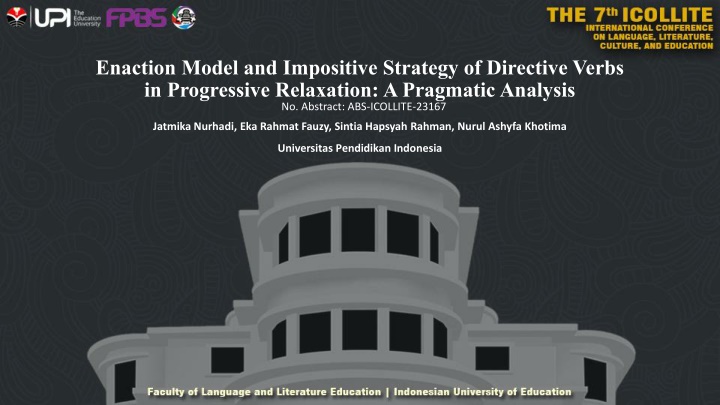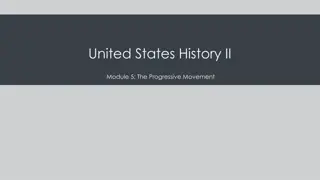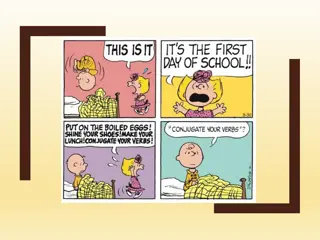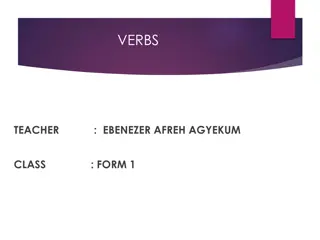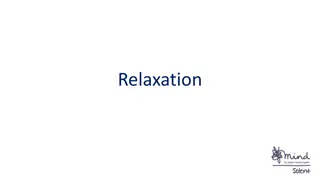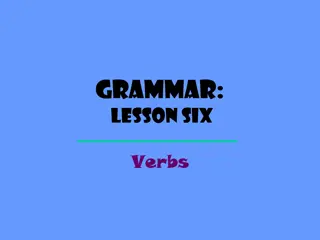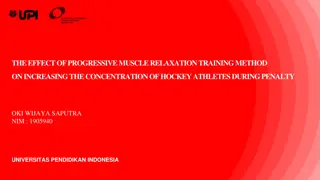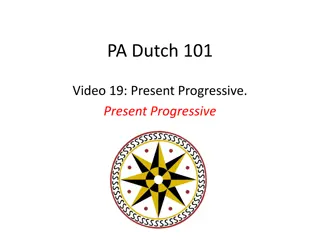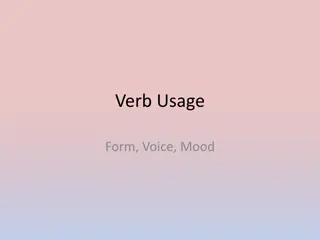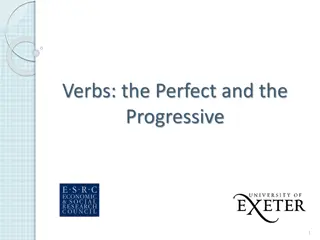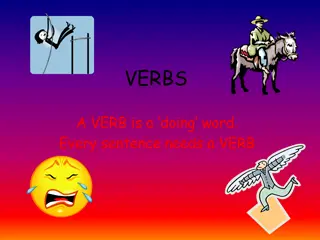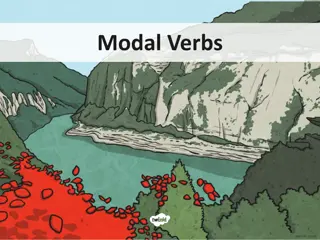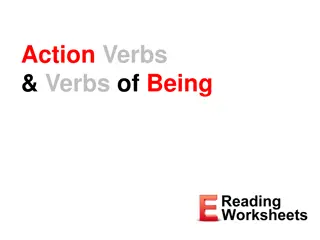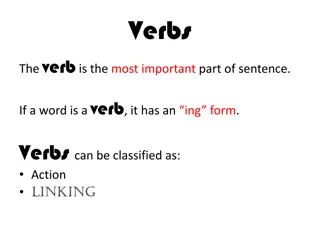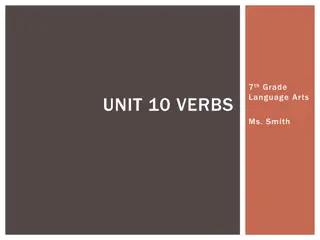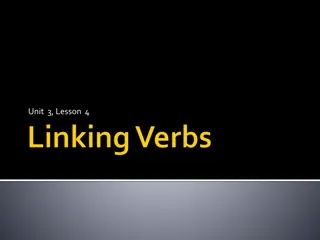Pragmatic Analysis of Directive Verbs in Progressive Relaxation
In this study, the Enaction Model and Impositive Strategy are applied to analyze the directive speech acts in Progressive Relaxation, a technique used in hypnosis. The research uses qualitative methods to examine the scripts and classifies the directive speech acts based on specific models. Previous studies on perlocutionary effects in various contexts are also referenced in the literature review.
Download Presentation

Please find below an Image/Link to download the presentation.
The content on the website is provided AS IS for your information and personal use only. It may not be sold, licensed, or shared on other websites without obtaining consent from the author.If you encounter any issues during the download, it is possible that the publisher has removed the file from their server.
You are allowed to download the files provided on this website for personal or commercial use, subject to the condition that they are used lawfully. All files are the property of their respective owners.
The content on the website is provided AS IS for your information and personal use only. It may not be sold, licensed, or shared on other websites without obtaining consent from the author.
E N D
Presentation Transcript
Enaction Model and Impositive Strategy of Directive Verbs in Progressive Relaxation: A Pragmatic Analysis No. Abstract: ABS-ICOLLITE-23167 Jatmika Nurhadi, Eka Rahmat Fauzy, Sintia Hapsyah Rahman, Nurul Ashyfa Khotima Universitas Pendidikan Indonesia
INTRODUCTION In hypnosis, the process of moving consciousness from a conscious state to a subconscious state is referred to as induction (Wong and Hakim, 2009). This process is also referred to as trance. The induction in hypnosis to bring individuals into a trance state is Progressive Relaxation. To achieve trance state in Progressive Relaxation, a number of speeches are utilized; these speeches in hypnosis are also referred to as suggestions. Suggestions can have the power of influence or the power of persuasion. The power of influence or power of persuasion in speech is studied in pragmatics. This power is contained in an action called a perlocutionary act. The perlocutionary act in the speech of Progressive Relaxation in this study is limited to the verb of directive speech acts. These directive speech acts will be classified into Enaction Model and Impositive Strategy.
LITERATURE REVIEW To classify the verbs of directive speech acts in this study, the Enaction Model of Ballmer and Brennenstuhl (1981) will be used. Meanwhile, to classify the Impositive Strategy in this study will use the Straightforwardness Scale of Blum-Kulka & Olshtain (1984) and Blum-Kulka et al. (1989). Some Previous Research: Roth et al. (2017) studied "Diabetes and the Motivated Patient: Understanding Perlocutionary Effect in Health Communication". Darmayanti et al. (2018) conducted a study entitled "Language Aspects in Hypnosis Dental Therapy: Pragmatic and Stylistic Studies". Bigunova (2018) conducted a study entitled "Illocutionary Aims and Perlocutionary Effect of Praise and Compliment Speech Acts in Modern English Literary Discourse". Dewi (2021) studied "An Analysis of Illocutionary and Perlocutionary Speech Acts of An Instagram Online Shopping Account". Annisa & Suparto (2022) conducted a study entitled "Directive Illocutionary and Perlocutionary Act in Now You See Me 1 Movie".
METHOD The method used in this research is qualitative method. The data source in this research comes from the Progressive Relaxation Induction Script contained in the Hypnotherapy Module of Indonesian Board of Hypnotherapy. There are 34 utterances that contain directive speech acts in Progressive Relaxation induction. The data were collected using documentation technique. The data that has been collected is then classified by Enaction Model and Impositive Strategy.
FINDING AND DISCUSSION Based on the analysis, it is found that the Progressive Relaxation script contains 34 directive speech acts. Then the 34 speech acts were classified using the Enaction Model and the speech act verbs (SAV) were found as follows. Focusing Directive Speech Verbs = 13 utterances, see Data (01) Commanding Directive Action Verb = 1 utterance, see Data (02) Soothing Directive Action Verbs = 20 utterances, see Data (03) The following are examples of the utterances containing SAV above. (01) Perhatikan otot-otot dan syaraf di sekitar mata Anda! (002/PR) Pay attention to the muscles and nerves around your eyes! (02) Silakan tarik napas panjang dan tutuplah mata saat Anda menghembuskan napas! (001/PR) Please take a deep breath and close your eyes as you exhale! (03) Lemaskan dan lepaskan semua ketegangan yang ada di sana! (003/PR) Relax and release all the tension that is there!
FINDING AND DISCUSSION Then the directive speech acts are reclassified using the Impositive Strategy. Out of 34 utterances, 32 utterances use Impositive Strategy, while 2 utterances do not use Impositive Strategy. All Impositive Strategies used are Mood Derivable (MD). Impositive Strategy: Utterances with MD SAV Focusing = 2 (04) Sekarang perhatikan bagian wajah Anda! (009/PR) Now look at your face! Utterances with MD SAV Commanding = 1 (05) Silakan tarik napas panjang dan tutuplah mata saat Anda menghembuskan napas! (001/PR) Please take a deep breath and close your eyes as you exhale! Speech with MD SAV Soothing = 20 (06) Lemaskan, lemaskan dahi Anda! (007/PR) Relax, relax your forehead! Nonimpositive Strategy: Utterance with Strong Hint (SH) SAV Focusing = 2 (07) Saat Anda perhatikan tangan Anda, saat Anda memperhatikan setiap tulang dan otot, rasa santai tadi menjalar ke tangan Anda. (022/PR) When you look at your hands, when you look at every bone and muscle, that relaxed feeling spreads to your hands.
CONCLUSION The utilization of Enaction Model and Impositive Strategy can produce the classification of directive speech acts in Progressive Relaxation. Based on the results of the analysis that has been done in the induction of Progressive Relaxation, it utilizes a number of Speech Action Verbs (SAV) and utilizes strategies in speech. There are three SAVs used in the induction of Progressive Relaxation, namely Focusing, Commanding, and Calming. Calming SAV is the most dominant SAV used. There is one type of Impositive Strategy used, namely Mood Derivable. Meanwhile, there is one type of Nonimpositive Strategy used, namely Strong Hints.
REFERENCES Annisa, H., & Suparto, S. (2022). Directive Illocutionary and Perlocutionary Act in Now You See Me 1 Movie. JEdu: Journal of English Education, 2(3), 223 231. https://doi.org/10.30998/jedu.v2i3.7160 Dewi, C. W. (2021). An Analysis of Illocutionary and Perlocutionary Speech Acts of An Instagram Online Shopping Account. Professional Journal of English Education, 4(3). Ballmer, T. T., & Brennenstuhl, W. (1981). Speech Act Classification (Vol. 8). Springer Berlin Heidelberg. https://doi.org/10.1007/978-3-642-67758-8 Bigunova, N. (2018). Illocutionary Aims and Perlocutionary Effect of Praise and Compliment Speech Acts in Modern English Literary Discourse. Odessa Linguistic Journal, 11, 12 20. Blum-Kulka, S., House, J., & Kasper, G. (1989). Investigating cross-cultural pragmatics: An introductory overview. Cross- cultural pragmatics: Requests and apologies, 31, 1 34. Blum-Kulka, S., & Olshtain, E. (1984). Requests and apologies: A cross-cultural study of speech act realization patterns (CCSARP). Applied linguistics, 5(3), 196 213 Darmayanti, N., Ekawati, D., & Erlina, W. (2018). Language Aspects in Hypnosis Dental Therapy: Pragmatic and Stylistic Studies. International Journal of Language and Linguistics, 5(2). https://doi.org/10.30845/ijll.v5n2p10 Roth, E. G., Girling, L. M., Chard, S., Wallace, B. H., & Eckert, J. K. (2017). Diabetes and the Motivated Patient: Understanding Perlocutionary Effect in Health Communication. https://doi.org/10.1080/10410236.2016.1140270 Wong, W., & Hakim, A. (2009). Dahsyatnya hipnosis. Visimedia. Health Communication, 32(4), 502 508.
THANK YOU! Follow us @jatmikanurhadi
